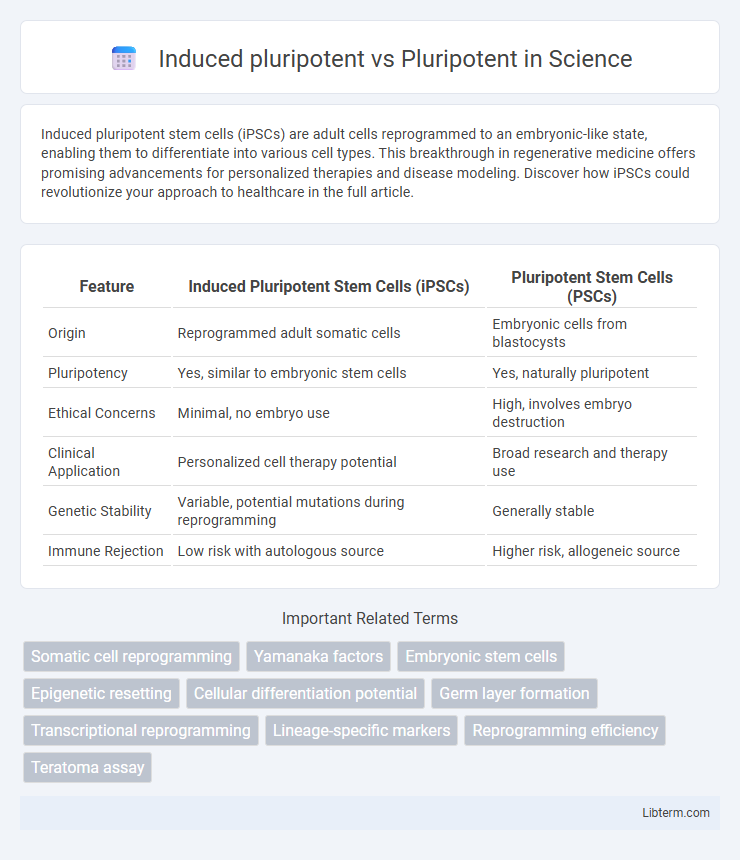Induced pluripotent stem cells (iPSCs) are adult cells reprogrammed to an embryonic-like state, enabling them to differentiate into various cell types. This breakthrough in regenerative medicine offers promising advancements for personalized therapies and disease modeling. Discover how iPSCs could revolutionize your approach to healthcare in the full article.
Table of Comparison
| Feature | Induced Pluripotent Stem Cells (iPSCs) | Pluripotent Stem Cells (PSCs) |
|---|---|---|
| Origin | Reprogrammed adult somatic cells | Embryonic cells from blastocysts |
| Pluripotency | Yes, similar to embryonic stem cells | Yes, naturally pluripotent |
| Ethical Concerns | Minimal, no embryo use | High, involves embryo destruction |
| Clinical Application | Personalized cell therapy potential | Broad research and therapy use |
| Genetic Stability | Variable, potential mutations during reprogramming | Generally stable |
| Immune Rejection | Low risk with autologous source | Higher risk, allogeneic source |
Introduction to Pluripotency
Pluripotency refers to the ability of a stem cell to differentiate into any cell type within the three germ layers: ectoderm, mesoderm, and endoderm. Induced pluripotent stem cells (iPSCs) are somatic cells reprogrammed back to a pluripotent state, mirroring embryonic pluripotent stem cells (ESCs) in differentiation potential. Both iPSCs and ESCs are critical in regenerative medicine for their capacity to generate diverse cell types for therapeutic applications.
What Are Pluripotent Stem Cells?
Pluripotent stem cells possess the ability to differentiate into nearly all cell types of the body, excluding extra-embryonic tissues, which makes them essential for regenerative medicine and developmental biology studies. Induced pluripotent stem cells (iPSCs) are genetically reprogrammed adult cells that exhibit similar pluripotency as embryonic stem cells (ESCs), providing a patient-specific and ethically favorable source for therapeutic applications. Understanding the molecular markers and differentiation potential of pluripotent stem cells advances their use in disease modeling, drug discovery, and personalized medicine.
The Discovery of Induced Pluripotent Stem Cells
The discovery of induced pluripotent stem cells (iPSCs) revolutionized regenerative medicine by demonstrating that mature somatic cells can be reprogrammed back into a pluripotent state, similar to embryonic pluripotent stem cells (ESCs). This breakthrough was achieved in 2006 by Shinya Yamanaka, who identified key transcription factors--Oct4, Sox2, Klf4, and c-Myc--that reset cell identity without the ethical concerns associated with ESCs. iPSCs exhibit self-renewal and the ability to differentiate into all three germ layers, enabling advanced disease modeling and personalized therapeutic approaches.
Key Differences: Pluripotent vs Induced Pluripotent
Pluripotent stem cells naturally occur in the inner cell mass of the blastocyst and can differentiate into nearly all cell types of the body, whereas induced pluripotent stem cells (iPSCs) are artificially reprogrammed from adult somatic cells to exhibit similar pluripotency. A key difference lies in their origin: pluripotent stem cells derive from embryonic tissue, raising ethical concerns, while iPSCs bypass this by using adult cells, enabling patient-specific therapies with reduced risk of immune rejection. Pluripotent cells possess a more stable genetic and epigenetic profile compared to iPSCs, which may harbor reprogramming-induced mutations or incomplete reprogramming states.
Methods of Creating Induced Pluripotent Stem Cells
Induced pluripotent stem cells (iPSCs) are generated by reprogramming adult somatic cells through the introduction of key transcription factors, typically OCT4, SOX2, KLF4, and c-MYC, using viral vectors such as retroviruses or lentiviruses. Alternative non-integrating methods include episomal plasmids, Sendai virus, mRNA transfection, and protein delivery to reduce genomic alteration risks. These techniques enable the conversion of differentiated cells into a pluripotent state, comparable to embryonic pluripotent stem cells, allowing for patient-specific cell therapy and disease modeling.
Advantages of Induced Pluripotent Stem Cells
Induced pluripotent stem cells (iPSCs) offer significant advantages over embryonic pluripotent stem cells by eliminating ethical concerns since they are reprogrammed from adult somatic cells rather than derived from embryos. iPSCs provide patient-specific genetic matches, reducing the risk of immune rejection in regenerative medicine and personalized therapies. Their ability to differentiate into any cell type makes iPSCs a powerful tool for disease modeling, drug screening, and potential therapeutic applications.
Limitations and Challenges of iPSCs
Induced pluripotent stem cells (iPSCs) face significant challenges including genomic instability, incomplete reprogramming, and potential tumorigenicity, which limit their clinical applications compared to naturally pluripotent embryonic stem cells (ESCs). The epigenetic memory retained in iPSCs can affect their differentiation efficiency and function, posing obstacles for regenerative therapies and disease modeling. Moreover, variations in reprogramming methods and donor cell sources contribute to inconsistencies in iPSC quality and reproducibility, complicating standardization efforts.
Applications in Regenerative Medicine
Induced pluripotent stem cells (iPSCs) and embryonic pluripotent stem cells both possess the ability to differentiate into any cell type, making them invaluable for regenerative medicine. iPSCs offer the advantage of patient-specific therapy, reducing immune rejection risks in treatments for neurodegenerative diseases, cardiovascular conditions, and tissue repair. Embryonic pluripotent stem cells provide a robust source for generating functional tissues but face ethical challenges and immunogenicity concerns in clinical applications.
Ethical Considerations and Implications
Induced pluripotent stem cells (iPSCs) circumvent ethical concerns associated with embryonic pluripotent stem cells by avoiding the destruction of embryos, making them a more ethically acceptable option in regenerative medicine. Pluripotent embryonic stem cells raise significant ethical debates due to their derivation from human embryos, which involves moral objections related to the beginning of human life. The use of iPSCs reduces ethical controversies, enabling broader research applications while adhering to strict regulatory guidelines protecting human dignity.
Future Perspectives and Research Directions
Induced pluripotent stem cells (iPSCs) offer promising future perspectives by enabling patient-specific therapies and disease modeling without ethical concerns tied to embryonic pluripotent stem cells (ESCs). Research directions focus on enhancing the efficiency and genomic stability of iPSC reprogramming, improving differentiation protocols for targeted cell types, and addressing potential tumorigenicity. Advances in gene editing technologies like CRISPR-Cas9 combined with iPSC platforms pave the way for personalized regenerative medicine and novel drug discovery.
Induced pluripotent Infographic

 libterm.com
libterm.com